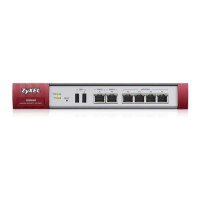ZyWALL Series CLI Reference Guide
165
CHAPTER 17
Trunks
This chapter shows you how to configure trunks on your Zyxel Device.
17.1 Trunks Overview
You can group multiple interfaces together into trunks to have multiple connections share the traffic
load to increase overall network throughput and enhance network reliability. If one interface’s
connection goes down, the Zyxel Device sends traffic through another member of the trunk. For
example, you can use two interfaces for WAN connections. You can connect one interface to one ISP
(or network) and connect the another to a second ISP (or network). The Zyxel Device can balance the
load between multiple connections. If one interface's connection goes down, the Zyxel Device can
automatically send its traffic through another interface.
You can use policy routing to specify through which interface to send specific traffic types. You can use
trunks in combination with policy routing. You can also define multiple trunks for the same physical
interfaces. This allows you to send specific traffic types through the interface that works best for that type
of traffic, and if that interface’s connection goes down, the Zyxel Device can still send its traffic through
another interface.
17.2 Trunk Scenario Examples
Suppose one of the Zyxel Device's interfaces is connected to an ISP that is also your Voice over IP (VoIP)
service provider. You may want to set that interface as active and set another interface (connected to
another ISP) to passive. This way VoIP traffic goes through the interface connected to the VoIP service
provider whenever the interface’s connection is up.
Another example would be if you use multiple ISPs that provide different levels of service to different
places. Suppose ISP A has better connections to Europe while ISP B has better connections to Australia.
You could use policy routing and trunks to send traffic for your European branch offices primarily
through ISP A and traffic for your Australian branch offices primarily through ISP B.

